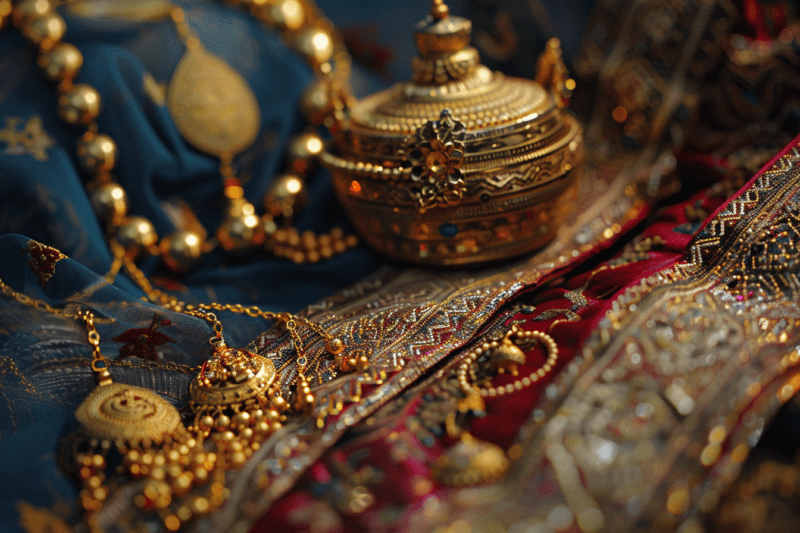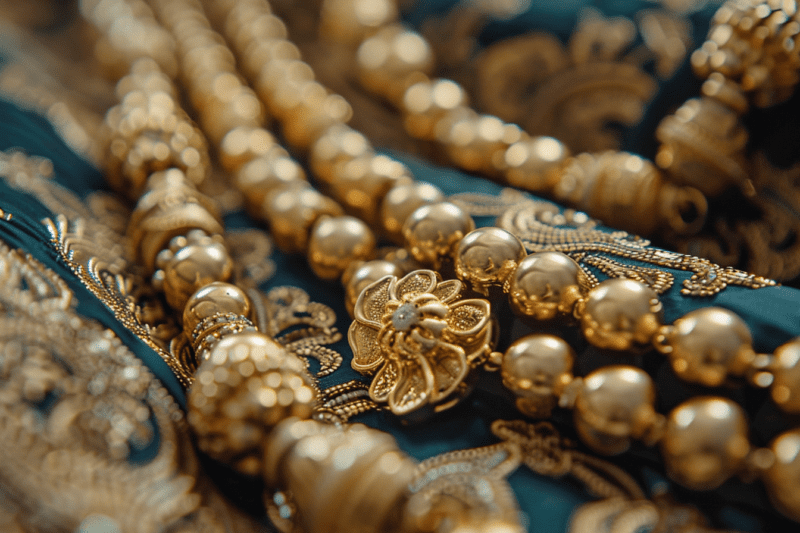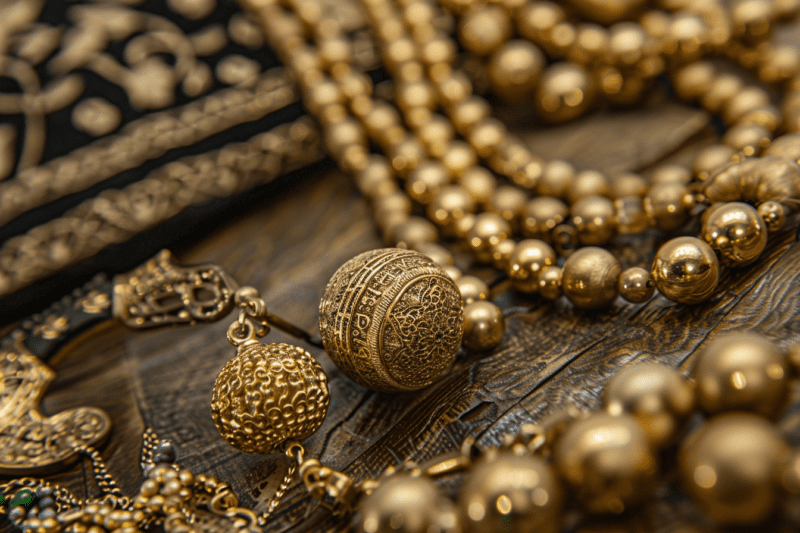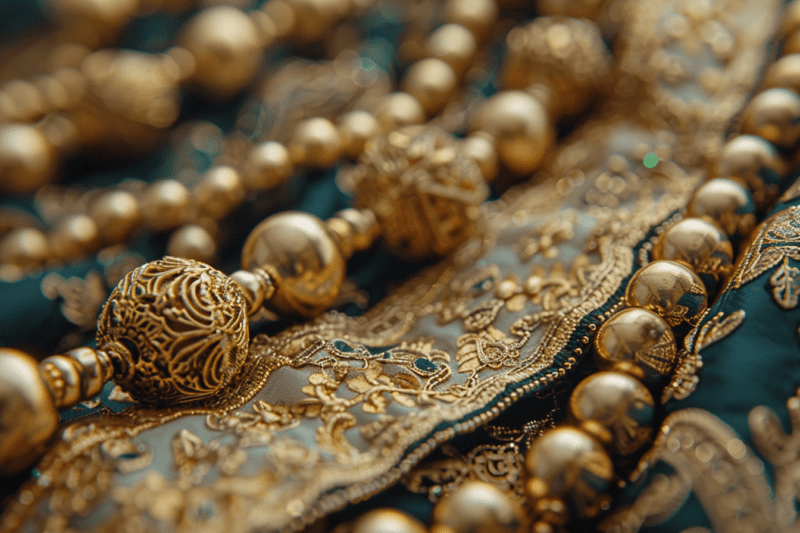Gold holds great significance in Islam, encompassing religious, socio-economic, symbolic, ethical, and future-oriented dimensions. Understanding gold in Islam, the importance of gold in Islamic culture, Islamic views on gold and its multifaceted role sheds light on its deep-rooted presence within Islamic societies.

Understanding the Religious Significance of Gold in Islam
The Quranic Perspective on Gold
In the Islamic faith, the Quran acknowledges gold as a precious metal. It is mentioned in various verses, emphasising its value and beauty. Gold is often associated with prosperity and abundance, mentioned in relation to Paradise and rewards in the afterlife.
Furthermore, the Quran describes gold as a symbol of purity and goodness, reflecting the divine nature of gold in Islamic history as precious metal. Its mention in the holy text signifies not just material wealth or Islamic jewellery but also spiritual richness and blessings.
Gold in Islamic Rituals and Traditions
Gold plays a vital role in Islamic rituals and traditions. It is prominently used in ceremonies such as weddings, where it symbolises wealth and blessings. Gold jewellery is often exchanged between spouses as a sign of commitment and love.
Moreover, the pilgrimage to Mecca known as Hajj features the veneration of the Kaaba, draped in a gold-embroidered cover known as the Kiswah. This represents the importance of gold in Islamic sacred spaces and rituals.
Additionally, gold holds significance in Islamic finance and charity. Zakat, one of the Five Pillars of Islam, requires the donation of a portion of one’s wealth, including gold, to help those in need. This act of giving reinforces the idea of wealth as a means of social responsibility and community support.

The Socio-Economic Importance of Gold in Islamic Societies
Gold as a Form of Wealth and Status
Gold has historically been regarded as a symbol of wealth and social status in Islamic societies. It is seen as a store of value and a hedge against inflation. Gold jewelry and ornaments serve as both personal adornments and tangible assets, representing financial security and prestige.
Furthermore, the significance of gold in Islamic societies extends beyond its material value. The intricate craftsmanship and design of gold jewellery often carry cultural and religious symbolism, making them important heirlooms passed down through generations. These pieces not only hold monetary worth but also embody traditions and heritage, adding layers of meaning to their inherent beauty.
Gold in Islamic Finance and Economics
Islamic finance adheres to principles that prohibit interest-based transactions and promote economic justice. Gold holds a prominent place in Islamic finance as it can be used in various Sharia-compliant investment vehicles, such as gold-backed exchange-traded funds (ETFs), gold certificates, and commodity Murabaha transactions.
Moreover, the role of gold in Islamic economics goes beyond its financial applications. The stability and universal acceptance of gold as a valuable commodity have made it a reliable medium of exchange in Islamic trading practices for centuries. Its intrinsic value and durability have facilitated trade and commerce, fostering economic growth and prosperity within Islamic societies.
Additionally, gold serves as a means of preserving and transferring wealth across generations, contributing to the stability and growth of Islamic economies.

The Symbolic Meaning of Gold in Islamic Art and Architecture
Gold in Islamic Calligraphy and Manuscript Illumination
Islamic calligraphy, the art of beautiful writing, often incorporates gold for its aesthetic appeal. Gold leaf or ink highlights verses from the Quran, lending a divine touch to religious texts. Manuscripts and intricately illuminated Qurans are adorned with gold accents, elevating their beauty and spiritual significance.
Gold has long been revered in Islamic art for its symbolic significance. Beyond its aesthetic allure, gold symbolises purity, wisdom, and the divine light of Allah. The intricate use of gold in calligraphy and manuscript illumination not only enhances the visual appeal but also conveys a deeper spiritual message to the viewers, inviting contemplation and reverence.
The Use of Gold in Islamic Architectural Design
Islamic architecture showcases the extensive use of gold, particularly in domes, minarets, and dome ceilings. The shimmering golden surfaces evoke a sense of grandeur and reflect the abundant blessings of God. This architectural style is most notably seen in landmarks such as the Dome of the Rock in Jerusalem and the Great Mosque of Cordoba in Spain.
Gold in Islamic architectural design goes beyond mere decoration; it serves as a symbol of the heavenly splendour and the eternal beauty of paradise. The intricate patterns and designs in gold embellishments not only demonstrate the craftsmanship of artisans but also reflect the spiritual aspirations of the Islamic faith, aiming to create spaces that inspire awe and devotion in worshippers and visitors alike.

The Ethical Considerations of Gold in Islam
Islamic Teachings on the Ethical Use of Gold
Islam places ethical guidelines on the use of gold. Extravagant displays of wealth and excessive adoration of gold are discouraged, as they may lead to greed and pride. Islam emphasises moderation and encourages the ethical acquisition and responsible use of gold.
In Islamic tradition, gold holds a significant place not only as a form of currency or adornment but also as a symbol of purity and value. The Prophet Muhammad himself spoke about the importance of using gold in a way that does not lead to arrogance or exploitation of others. This emphasis on ethical conduct extends to all aspects of life, including the handling of precious metals like gold.
The Impact of Gold Mining on Muslim Communities
The environmental and social impact of gold mining raises concerns in many Muslim-majority regions. Mining practices that harm ecosystems and local communities contradict Islamic teachings on stewardship and social responsibility. Efforts are underway to promote sustainable and ethical gold mining practices in alignment with Islamic values.
Communities in regions where gold mining is prevalent often face challenges such as water pollution, deforestation, and displacement. These issues not only affect the environment but also disrupt the social fabric of these areas, leading to tensions and conflicts. Islamic scholars and environmental activists are working together to address these challenges and find solutions that respect both the natural world and the communities that rely on it for their livelihoods.

The Future of Gold in Islam
Modern Interpretations and Debates Around Gold in Islam
As societies evolve, there are ongoing debates about the role and interpretation of gold in Islam. Some scholars question the extent to which traditional practices surrounding gold align with contemporary social and economic realities. These discussions aim to ensure that Islamic practices relating to gold remain relevant and meet the needs of future generations.
One aspect that is often debated is the use of gold in Islamic finance. While gold has historically been a symbol of wealth and stability in Islamic societies, its role in modern financial systems is a topic of discussion. Some argue that gold-backed currencies could provide a more stable financial system, while others believe that digital currencies may offer a more practical solution in the digital age.
The Role of Gold in Shaping the Future of Islamic Societies
Gold will continue to play a significant role in shaping the future of Islamic societies. As economies advance, Islamic financial institutions are exploring innovative ways to integrate gold into banking and investment products. Promoting sustainable and ethical gold mining practices will further strengthen the connection between gold and Islamic values, ensuring a prosperous and responsible future for Muslims worldwide.
Furthermore, the cultural significance of gold in Islamic societies cannot be understated. Gold jewellery, for example, holds deep symbolic value in many Muslim communities, often representing milestones in a person's life such as weddings, births, or religious ceremonies. The craftsmanship and intricate designs of gold jewellery also reflect the rich artistic heritage of Islamic cultures, showcasing the blending of traditional motifs with contemporary styles.
In conclusion, the significance of gold in Islam extends beyond material wealth. It is intertwined with religious observances, reflects social standing, inspires artistic expression, and raises ethical considerations. As Islamic societies progress, gold will remain central to their cultural, economic, and spiritual fabric, embodying traditions while adapting to evolving contexts.








Article
The Significance of Gold in Islam
Gold holds profound significance in Islam, encompassing religious, cultural, and historical dimensions. This article provides an insightful exploration into why gold is cherished in Islamic traditions and practices, highlighting its enduring value and symbolic meaning within the faith.